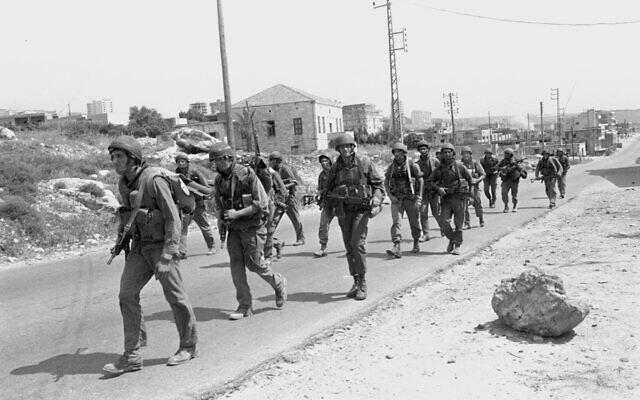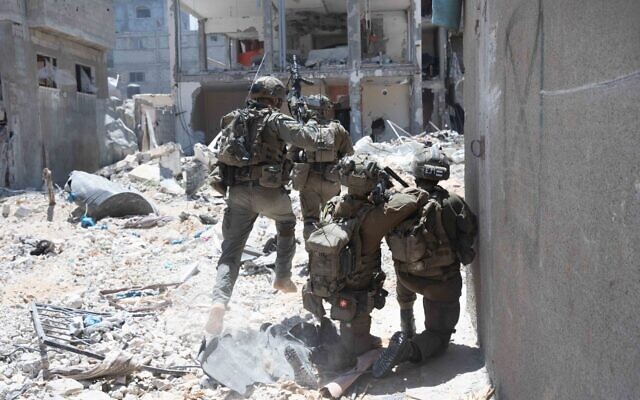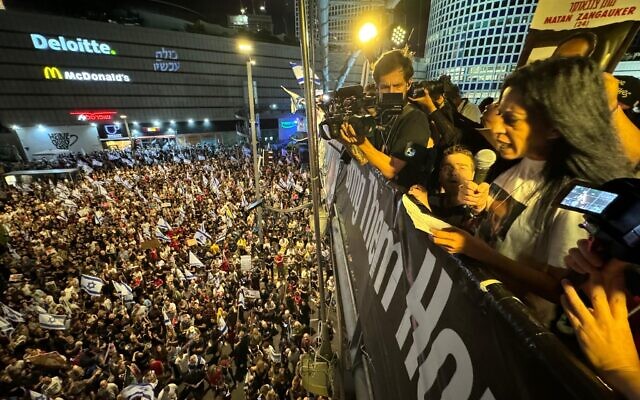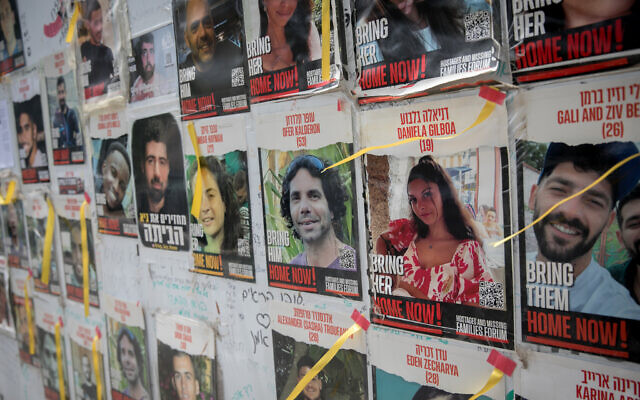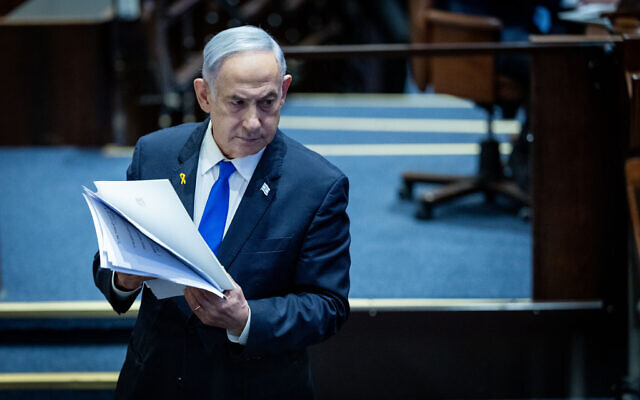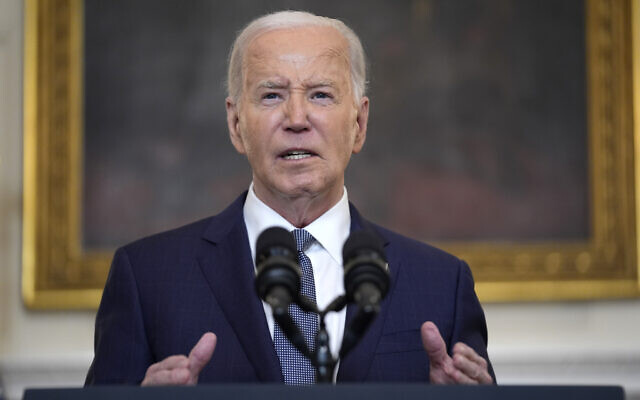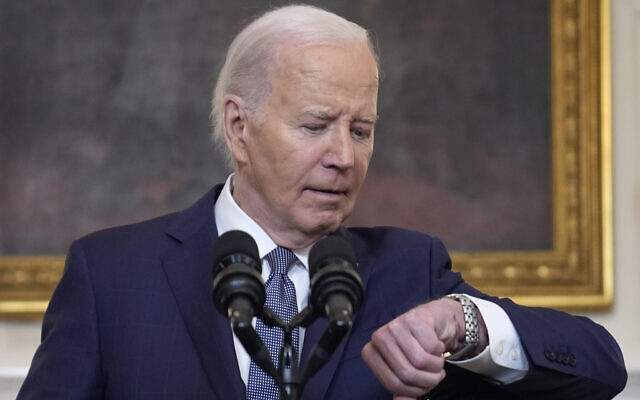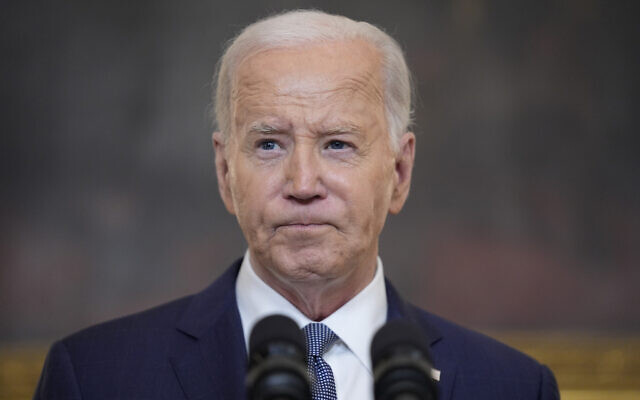Wasting troops’ hard-fought gains, Israel is taking time it doesn’t have in Gaza
Facing a war in which speed would be paramount, the army found itself having to take it slow due to decisions made decades ago; 7 months on, Hamas is hoping to run out the clock

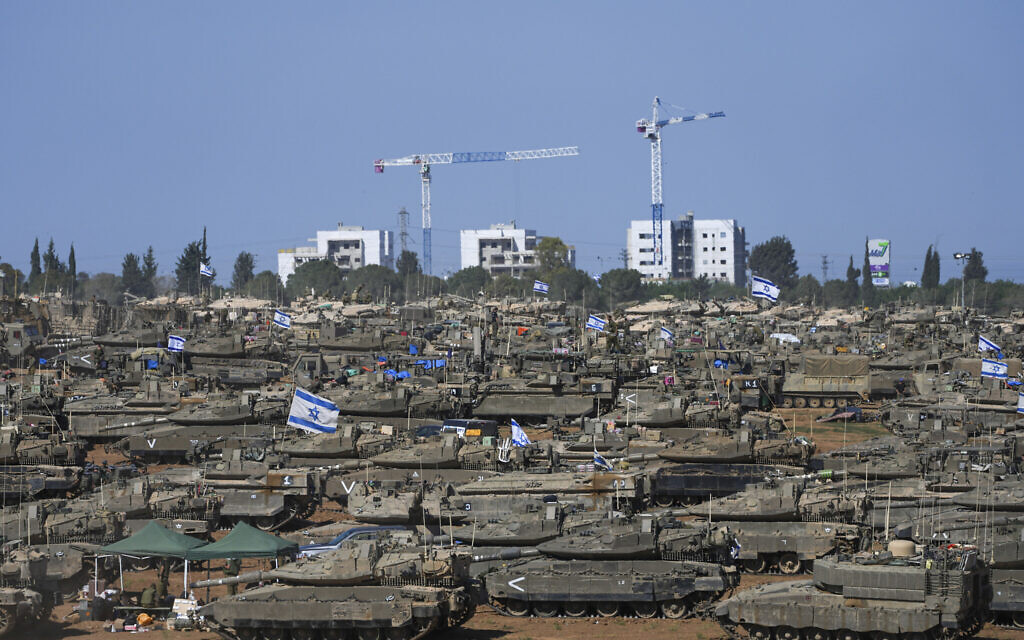
Seven months after it carried out the worst massacre of Jews since the Holocaust, Hamas is still very much alive and kicking.
It has reportedly reasserted significant civil control in Gaza cities troops swept through and then left. In some areas, Hamas fighters have resumed their rocket fire, including a recent attack on Sderot and the deadly strike on Israel Defense Forces infantrymen near Kerem Shalom on Sunday.
Not only is Hamas surviving, it looks increasingly plucky about its chances to guarantee its return to power.
The recent Kerem Shalom rocket strike that killed four troops was evidence of Hamas’s mood, argued Meir Ben-Shabbat, Prime Minister Benjamin Netanyahu’s former national security adviser.
“It reflects the self-confidence of Hamas commanders who didn’t hesitate to initiate such an attack, from a humanitarian zone, during critical negotiations for the organization despite the risk of damaging a vital supply artery for the population,” said Ben-Shabbat, adding that the strike was intended to stress to Gazans that its attempts to force Israel into a ceasefire “come from a position of strength and not from surrender or fatigue.”
As the weeks go by, the world has shown a diminishing appetite for Israel’s defeat of Hamas. Almost no one talks about the dismantling of Hamas’s military capabilities anymore; the priority among Israel’s closest allies is to arrange a ceasefire and to get the hostages out.

But rather than move with lightning speed to finish the job, Israel’s military appears to have adopted a plodding pace that only allows plenty of time for resistance to the war’s continuation to build up, both abroad and domestically. And that resistance — most notably United States President Joe Biden’s warning that Israel won’t get offensive weapons if it goes into Rafah — will likely slow the campaign even further.
Not all of the blame can be laid at the feet of Israel’s political leadership. The IDF too, in decisions made years ago and after October 7, has played a central role in crafting a campaign that has been adrift for months.
A sluggish campaign
Not everyone agrees that there is something fundamentally wrong with the pace of the war. Ben-Shabbat explained that a long fight is unavoidable given the widespread public support Hamas enjoys, and its deep roots among the population.

“This is a complex challenge that demands determination and time, and includes significant challenges, like those around providing humanitarian aid to the population,” he explained, “as well as the need to avoid striking the hostages and to take advantage of opportunities to free them.”
Even in light of those challenges, the IDF seems more sluggish than it has in past conflicts, even those that were the most challenging.
During the 1973 Yom Kippur War, the IDF managed to stem two surprise invasions, to counterattack within the first week, and have both Egypt and Syria on their heels within 19 days.
Low-intensity fighting did continue for months, but only after the IDF very quickly knocked two large, well-armed foes out simultaneously.
Today, managing a two-front war seems an unfathomably tall order for Israel’s military.
“It cannot conduct a serious offensive against Hezbollah while it is fighting Hamas,” lamented Eado Hecht, a defense analyst at the Begin-Sadat Center at Bar-Ilan University.
But even focusing on just a single foe — Hamas in Gaza — the IDF has taken its time.
It took three weeks to even begin the ground offensive in Gaza after October 7, wasting valuable time with reservists mobilized and international goodwill still strong.
When it did finally move in, it launched a torpid staged advance into Gaza designed to last several months as it moved north to south, rather than aggressively taking Rafah and the strategic Egypt-Gaza border area in the first phase along with Gaza City.
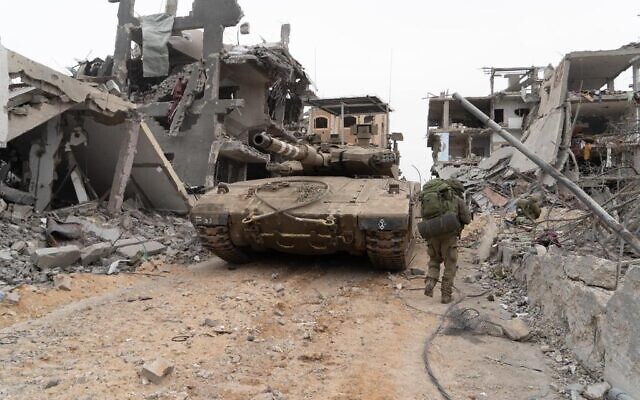
Despite impressive tactical achievements wherever IDF troops have operated, the military effort to crush Hamas as a coherent fighting force is unfinished, and it remains unclear that it ever will be completed — not to mention the years of clean-up operations afterward. Most brigades have long been pulled from Gaza.
Despite pulling up short of Rafah, Netanyahu has continually maintained that an IDF conquest of the southern Gaza city is vital to Israel’s war aims.
Back in February, Netanyahu said that Israel had only one month left to complete its upcoming operation in Rafah, before Ramadan.
A quiet Ramadan came and went, and Rafah remained in Hamas hands.
As the Muslim holy month ended, Netanyahu pledged again to go into Rafah and destroy the four battalions there. “This will happen. There is a date,” Netanyahu said in a video statement. It was one of four times since February he announced that he had authorized IDF operational plans for Rafah.

At long last, IDF tanks moved into the Rafah area Monday night, taking the border crossing with Egypt with ease.
But that incursion was still not the long-promised showdown with the bulk of Hamas’s remaining units. It was a “limited operation,” an Israeli official told The Times of Israel, implemented to pressure Hamas to accept a hostage deal.
On Tuesday, as Israeli troops operated around the Rafah Border Crossing, the Biden administration briefed a number of reporters that it had recently held up a large shipment of bombs that it feared Israel might use in Rafah, a clear warning to Israel not to expand the invasion. Then came Biden’s explicit warning on CNN that there would be consequences if Israel moves to complete the destruction of Hamas forces in Rafah.
A very deep hole
The roots of the unsatisfactory military performance at the operation and strategic levels — which have “dug Israel into a very deep hole in the ground, which will take a long time to climb out of,” according to Hecht — go back well before October 7.
“The IDF could have come closer to the objective in seven months if it had not made a series of professional mistakes over the past 25 years that reduced its capability to conduct this campaign better,” Hecht argued.
During Israel’s early decades, the IDF’s operational concept rested on aggressive movement by its ground forces into enemy territory, quickly shifting the fight away from population centers to deliver decisive — and rapid — defeats to adversary forces.
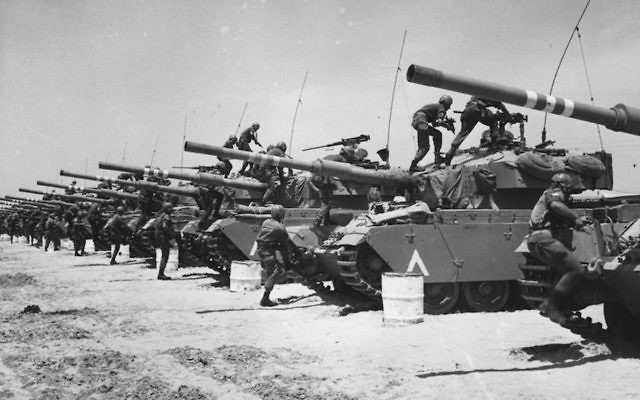
That approach was stunningly effective during the era of Israel’s victories over conventional armies. Arab divisions were unequivocally devastated on the battlefield within days or weeks, and captured territory was the basis for peace talks with the leaders of the hostile coalition, which saw members drop out with each defeat at the hands of Israeli ground forces.
The quick ground maneuver concept began to crumble after the 1973 Yom Kippur War. Though that conflict still ended with Israel’s ground forces notching a classic battlefield victory, the unexpected losses of IDF tanks at the hands of Egyptian and Syrian missiles, and an unprecedented lack of faith in leaders sending young men into battle, spurred Israelis to reconsider whether risking their lives in pitched battles was as necessary as they had been told.
The debate over the proper application of military force in Israel took place at the same time that US military thinkers were relying on their technological advantage to deal with the problem of the Soviet numerical advantage in Europe. Instead of meeting Russian armor head-on, they envisioned using precision missiles and improved intelligence capacity as the keys to devastating enemy forces. The stunning US victory over the large Iraqi army in 1991 underscored to Israel the potential of fighting smarter while risking fewer ground forces.
The strategy also obviated the need to capture and hold ground, seen increasingly by Israel as a liability in the wake of the First Palestinian Intifada and amid the long occupation of southern Lebanon by the IDF.
Given the belief that they would never again be asked to fight a conventional, high-intensity conflict, the ground forces were gradually reorganized and retrained to excel in low-intensity fights against guerrilla and terrorist forces. And if war against another army did break out, the air force, which received the lion’s share of innovative technology and budget increases, would be able to deliver decisive blows.
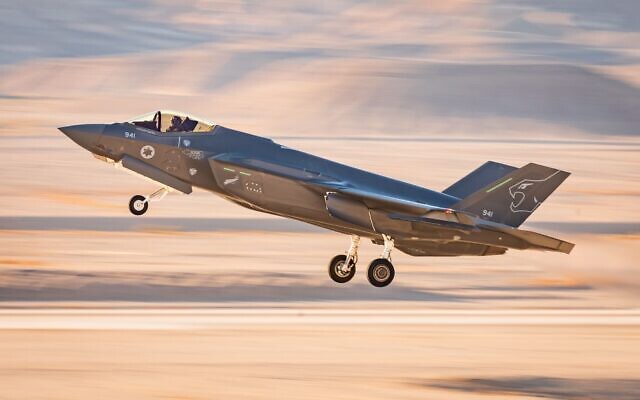
Israel’s military chiefs closed armored and artillery units, the source of the mobility and firepower needed in a high-intensity scrum for territory.
The infantry was also stripped down, with many of its medium and heavy capabilities — grenades, mortars, shoulder-fired missiles — retired or mothballed.
Netanyahu, who led the country during this shift away from ground forces, was firmly in the camp that saw ground maneuver as a vulnerability, not an asset.
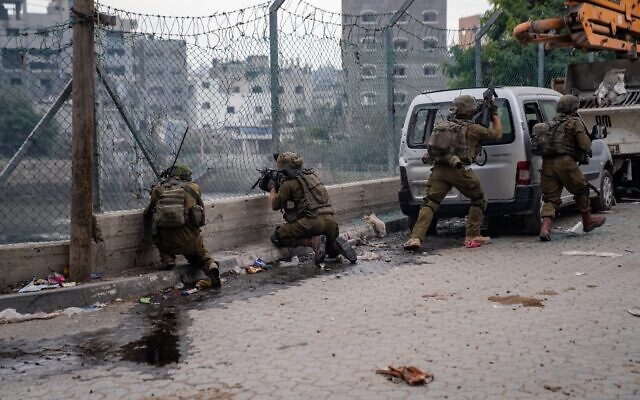
So after October 7, as Israeli planners scrambled to put together a campaign plan for conquering Gaza –something that had not existed for almost a decade — they found that they didn’t have sufficient forces.
Even if the planners had concluded that taking Rafah at the same time as Gaza City was the way to go, years of neglecting the pieces needed for such a maneuver meant the army could not seriously consider such an undertaking.
“Today, the IDF is incapable of a simultaneous offensive in a number of sectors in Gaza,” Hecht explained.
They also recognized that the reservists, insufficiently trained, needed several weeks to regain the ability to fight in a full-scale ground offensive. Hence the weeks of idling outside of Gaza.
“The delay in commencing ground operations, a sequenced campaign, a slow gradual offensive to enable the troops to acclimate to the new combat reality — high-intensity regular warfare — all lengthened the duration of operations,” Hecht pointed out. “After four months, Israel had to begin releasing reserves to return them to the economy.”
Ground forces learned lessons and improved quickly, but the majority of reserves were released just as they were overcoming the effects of years of neglect.

“During those four months, the achievements were remarkable,” he continued, “but less than could have been achieved if the IDF had been fully capable and big enough to commence the offensive immediately.”
There have been other signs of unsatisfactory military leadership at the highest levels. IDF leaders supported a major operation against Hezbollah in the wake of the October 7 attacks, which would have left Israel dangerously overstretched.
Reservists participating in planning sessions in “the Pit,” the IDF’s underground operations center in the Kirya, have come out frustrated with what they call “a war without shins” – the Hebrew letter that connotes when an operation is set to start, comparable to H-Hour in the US military. The campaign against Hamas, they told The Times of Israel, is devoid of firm timetables.
A new type of war
The Swords of Iron war is longer than previous Israeli conflicts because it has a fundamentally different political goal than Israel’s many previous campaigns, according to military theorist Eran Ortal.
“For the first time, Israel is committed not only to the defeat of the enemy’s forces but also to the annihilation of its regime,” writes Ortal.
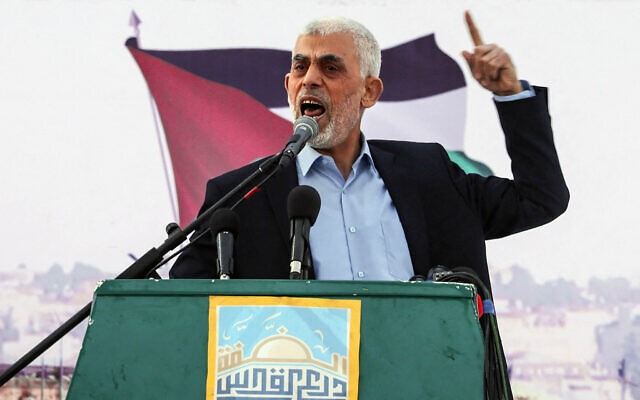
That type of campaign rests on replacing the enemy regime, in this case, Hamas.
But Israel’s government — in an attempt to keep the right flank of the coalition onboard — refused to begin installing a new regime while Hamas was underground. Doing so might have enhanced the pressure on Hamas, which would see an alternative to its rule taking hold at the same time that its military capabilities were being dismantled.
Instead, Hamas has remained without any serious challenger to its rule, and there is little reason for Gazans to do anything to resist the group as it returns to the areas that the IDF has left — which today is almost all of Gaza’s population centers.
“Hamas is running the Strip now in the absence of another organization to run it,” an IDF official told Kan News, “and that is the heart of the problem.”
While the campaign has been stuck in place for months, Israel continues to pay the price of being at war while not really fighting one anymore, suffering international isolation and a low boil of hostilities on its northern border.
Hezbollah leader Hassan Nasrallah might like to stop the exchange of fire across the Lebanon-Israel border, but he won’t do so until there is some sort of ceasefire in Gaza.
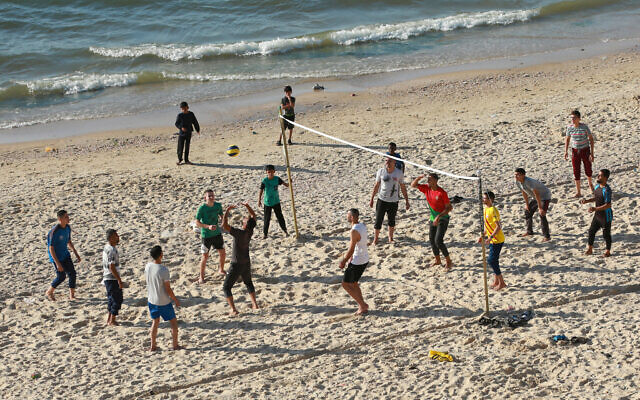
So, while some Gazans have begun returning to their homes, residents of Israel’s north are still refugees because the war in Gaza technically stretches on.
“Cornered now into a long total war against the Hamas regime, Israel can hardly sustain the effort needed and has no good solutions for the simultaneous threat from Lebanon,” Ortal argued.
And the longer the war in Gaza drags on, the longer Israel’s focus is on Hamas, and not on the even more serious threats of Hezbollah and Iran.
“What I have not heard from the IDF or the political echelon is a strategy to deal with Iran itself,” pointed out Jonathan Schanzer, senior vice president at the Foundation for the Defense of Democracies.
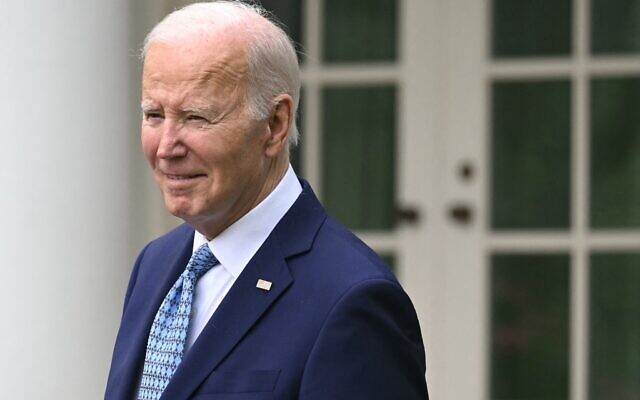
The White House hasn’t helped shorten the campaign either, even though it desperately wants it to end.
Trailing GOP challenger Donald Trump in polls, Biden — who has drawn the ire of progressives and Muslim-Americans for his support of Israel — wants to move the public debate in the US beyond the war in Gaza by putting the conflict in the rear-view mirror.
But his administration has done whatever it can to block, or at least significantly delay, an Israeli operation into Rafah that would allow Israel to declare the war itself over, insisting on detailed humanitarian plans and repeatedly expressing opposition to such a move.
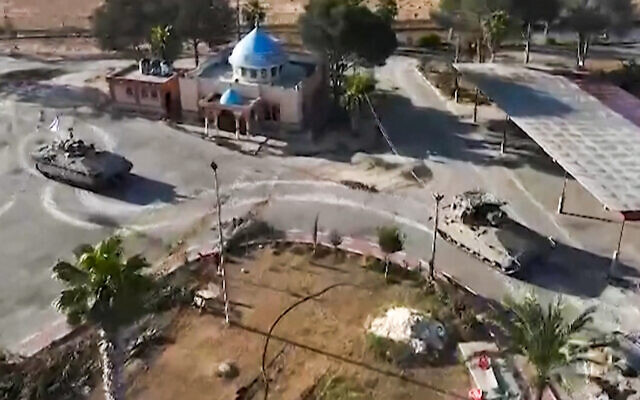
Instead, it is trying to effectively bring the war to an end through a ceasefire-for-hostages deal between Israel and Hamas. But, as the administration ramps up public pressure on Israel and calls for Israel to stay out of Rafah, officials consistently incentivize Hamas to hold out for a better deal. The longer Hamas waits, the more Israel’s relationships with allies fray.
Après moi, le déluge
An ark must be built before the flood. But when Hamas fighters poured across the border on October 7 in what it called Operation Al Aqsa Flood, the IDF wasn’t constructed for the war it had no choice but to fight.
Still, Israel has had enough time to recover and recreate itself for the complex campaign against Hamas. Yet its political and military leaders are taking their time, and avoiding the difficult decisions that people in their positions are expected to make.
Some will try to shift the blame to the Biden Administration. The White House has undoubtedly undermined the military threat to Hamas and done whatever it can to force a Rafah operation to be pushed off. But it is not Biden’s fault that the military campaign was designed to move slowly, and he would like nothing more than for Netanyahu to start replacing Hamas with a credible alternative on the ground.
Meanwhile, Yahya Sinwar, the mastermind of the October 7 atrocities, will for the foreseeable future continue to control the fate of Israeli hostages, residents of the south and 60,000 evacuated residents of Israel’s north, as Israel’s leaders and media wait anxiously for his decisions. He does not appear to be in any rush.
Are you relying on The Times of Israel for accurate and timely coverage right now? If so, please join The Times of Israel Community. For as little as $6/month, you will:
- Support our independent journalists who are working around the clock;
- Read ToI with a clear, ads-free experience on our site, apps and emails; and
- Gain access to exclusive content shared only with the ToI Community, including exclusive webinars with our reporters and weekly letters from founding editor David Horovitz.

We’re really pleased that you’ve read X Times of Israel articles in the past month.
That’s why we started the Times of Israel eleven years ago - to provide discerning readers like you with must-read coverage of Israel and the Jewish world.
So now we have a request. Unlike other news outlets, we haven’t put up a paywall. But as the journalism we do is costly, we invite readers for whom The Times of Israel has become important to help support our work by joining The Times of Israel Community.
For as little as $6 a month you can help support our quality journalism while enjoying The Times of Israel AD-FREE, as well as accessing exclusive content available only to Times of Israel Community members.
Thank you,
David Horovitz, Founding Editor of The Times of Israel


